ASIER MENDIZABAL
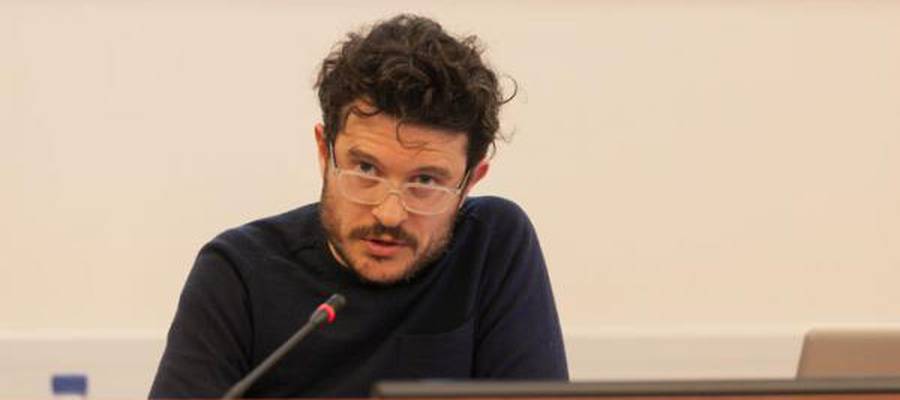
Asier Mendizabal (Ordizia, 1973) gipuzkoar artista bat da. 1996an Arte Ederretan lizentzia eskuratu zuen Euskal Herriko Unibertsitatean, eta Londresko Byam Shaw School of Art eskolan egin zituen graduondoko ikasketak 1997an, Erasmus beka bati esker. Gipuzkoako Foru Aldundiaren beka ere eskuratu zuen 1998an, eta 1999an Gipuzkoako Artista Gazteen Lehiaketan lehenengo saria lortu zuen. 1998tik 2000ra Amsterdamen osatu zuen bere prestakuntza. Hango De Ateliersen eta Donostiako Egiako Kultur Etxean egin zituen, hain zuzen, lehenengo bakarkako erakusketak (2000). Egian egindako No time for love bideo-instalazioari esker hautatu zuten 2000. urtean Gure Artea erakusketarako. Gaur egun Bilbon bizi da. Bergeneko Horlsaland Kunstsenter-en, Norbegian, Londreseko Raven Row-en, Madrileko Reina Sofian, Lisboako Culturgest-en, Donostian DAE produkzioko plataformarekin, eta Bartzelonako d'Art Contemporani Museoan bakarkako erakusketak egin ditu. Horretaz gain erakusketa kolektiboak ere burutu ditu; IllumiNATIONS Veneziako bienaleko 54, Scenarios about Europe, GZK Leipzig eta San Telmo museoan Donostian, In the first Circle Fundatió Tabieses Bartzelonan, Às Artes, Cidadãos,Museu Serralves, Porton; Després de la notícia, Bartzelonako Centre de Cultura Contemporànian , Manifesta 5 edo Taipei eta Bukarest bezalako Bienaletan.
Azpian Goierriko Irratian Ikusi Irratia deitzen dena Asier Mendizabalek eman duen elkarrizketa. Hark sortzen duena aurkezten digu. "Dakigula dakiguna era berri batean aurkeztu. Ezagutzen duguna ez ezagun balitz bezala aurkeztu. (...) Ikusmena ulermena zaildu egin behar da. Gakoa da zailtzea erraz dena. Oteizak kondizio mitiko batzuk sortu ditu lengaje abstrakto batekin. (...) Egiten duguna ez du arrakastarekin neurtzeko bokaziorik. Ez dut uste izan beharko lukenik. Posmodernidadearen klabea dena berdina dena errelatiboa da bakoitzak dauka bere ikuspuntua ikuspuntu guztiak dira onargarriak. Horren ondorioa da segurazko antxiedade hori eta atera behar dugu ikasbide hortik. Agian berreskuratu behar dugula alegia hierarkiak nolabait planteatzeko modu bat. Logika kultural horretan bertan gaudela oso eskerrekoa dela erresponsabilitate hartu ez izate hori. Posmodernidateak ekarri zuena zen halako bakoitzaren errantzukizunaren arintze bat. Eta errazagoa da bizitzea arintasun horrekin. Orain buelta etorriko zaigula. Laborategian egiten duguna baliagarria izan daiteke geure gaurkotasuna geure garaia irudikatzeko. Identifikatzeko zeintzuk diren geure garaiaren berezitasun horiek. Ikusten ez direnak hain justu aurrean dauzkagulako. " (Asier Mendizabal)
The press release for Basque artist Asier Mendizabal’s show at Raven Row indicates the artist’s interest in ‘the symbols through which cultures are represented’, an innocuous but relatively banal characterisation of his investigation into the visual codes of collective life and identity.
This description fails to indicate how elegantly he explores how ideology, belief and identity are simultaneously abstracted and made real in the process of being given visual form. And while Mendizabal’s practice is grounded in very thorough research, his engagement with the process of making ideology visible is not esoteric or dry – it does not adhere to any supposed split between intellectual reference and aesthetic form. Mendizabal successfully works with a variety of media and techniques to create compelling, often beautiful, objects and images; in addition, he provides explanatory texts (also beautifully designed) at two points in the exhibition.
Nom de guerre (2007)
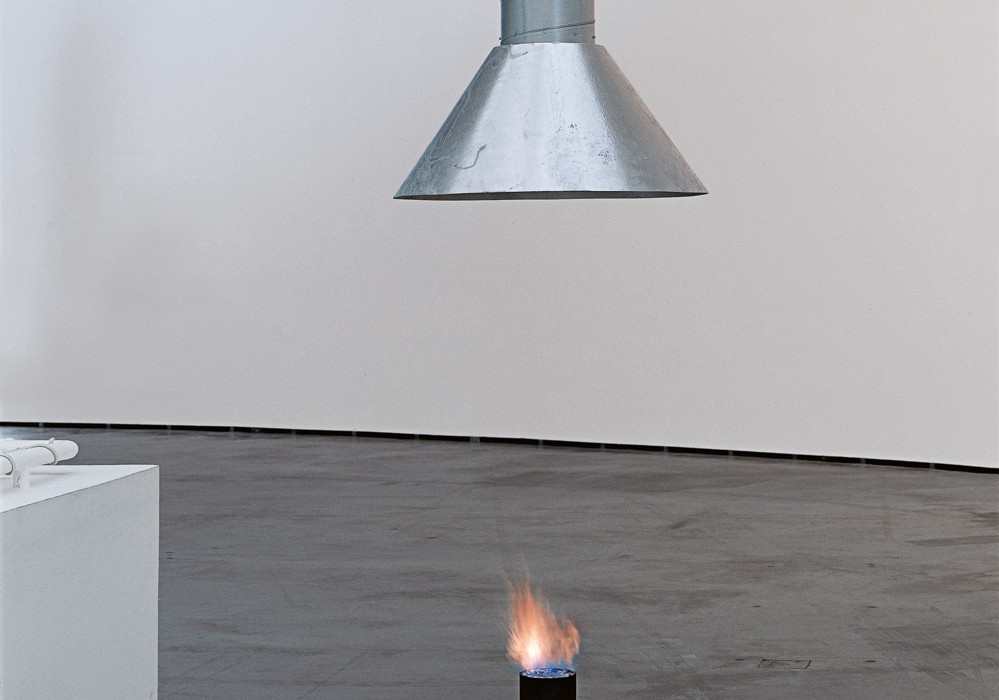
Nom de guerre (2007) Guggenheim Bilbao Museoaren testuinguru instituzionalerako asmatutako lana da. Bi osagai ditu: metalezko edukiontzi bat erregaiez betea, su-ontzi inprobisatu baten antzera etengabe sutan dagoena hormigoizko bloke baten gainean; eta hodi bertikal bat, museo barruan ezinbestekoa, kea bertatik kanpora husteko. Sinplea da baina aldi berean konplexua; esanahia da korapilatsua, funtsezko hiru eremurekin lotuta baitago: sua elementu sinboliko gisa, eskultura irudikapen kritikoaren ariketa gisa, eta gaur egun gizarteak bizi dituen hersturak.
Raven Row Galerian Londresen (2012)
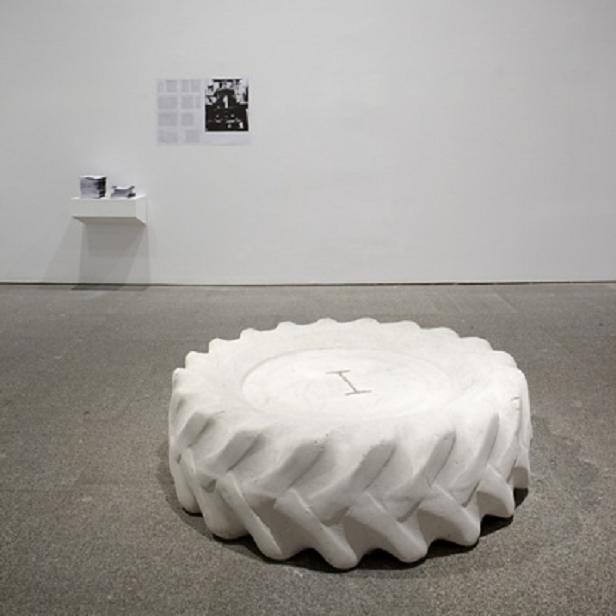
Another pamphlet, ‘Otxarkoaga/Targu Jiu/Hernani’, gives some background historical information for three pieces in Raven Row’s large ground floor gallery. This information has a supplementary function rather than a drily explanatory one – reading the text and then looking back at the work adds to its meaning rather than changing it entirely. ‘Untitled (Targu Jiu)’ is a concrete sculpture of a large tyre; the visual surprise of an unexpected material applied to a familiar object radically removes it from any function or use beyond sculptural presence, even if the concrete looks implausibly yielding, its surface worn and stretched in places like rubber.
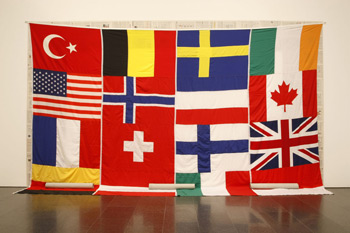
The piece ‘Bigger than a Cult, Smaller than a Mass (One, Two Backdrops)’ (2006), a tapestry of national flags stitched together and hung in front of a collage of newspapers mounted on the wall, invites questioning of how a specific ordering of lines and colours (which looks increasingly arbitrary when juxtaposed with other examples) becomes a ‘flag’ that can be read as a nation.
The form of a flag is only legible because of a prior and concurrent process of knowledge exchange, even if it is one that takes place almost automatically. Mendizabal disrupts this syncronisation by stitching the flags together in an apparently meaningless constellation, and thus proves that ‘form’ and ‘content’ together give an image ideological meaning. This might seem like quite an obvious point, but Mendizabal’s work expresses it with restraint, engaging in the very dynamic he investigates. Mendizabal interrupts the assumptions that enable cultures and beliefs to be represented visually (he detaches the signs from what they signify) and so proves that this process of making assumptions and identifying with them is assimilated rather than automatic.
Goierri Konpeti Filma
Goierriko bailaran Harkaitz eta bere lagunek baserri bat dute alokatuta. Orduak igarotzen dituzte han beraien kotxeetan lanean. Altxor bezala zaintzen dituzte gero errepide bihurgunetsuenetan abiaduraz gozatu ahal izateko. Aldaketaz betetako urte batean, Iñaki Garmendia eta Asier Mendizabal zuzendariek, gazte hauen jarraipena egin zuten, denborarekin kamera aurrean naturaltasun osoz ateratzen zirenak.
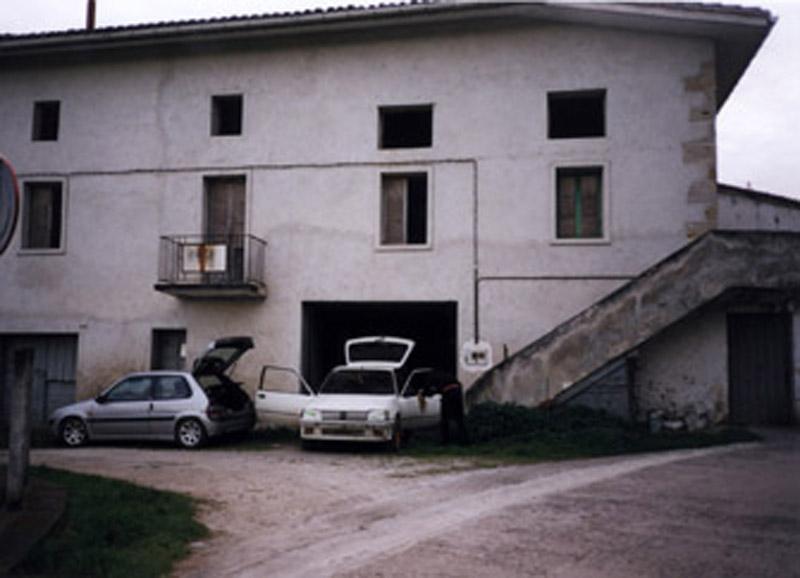
Goierri Konpeti, Iñaki Garmendia eta Asier Mendizabal, Espainia, 2003, 53', DCP.
